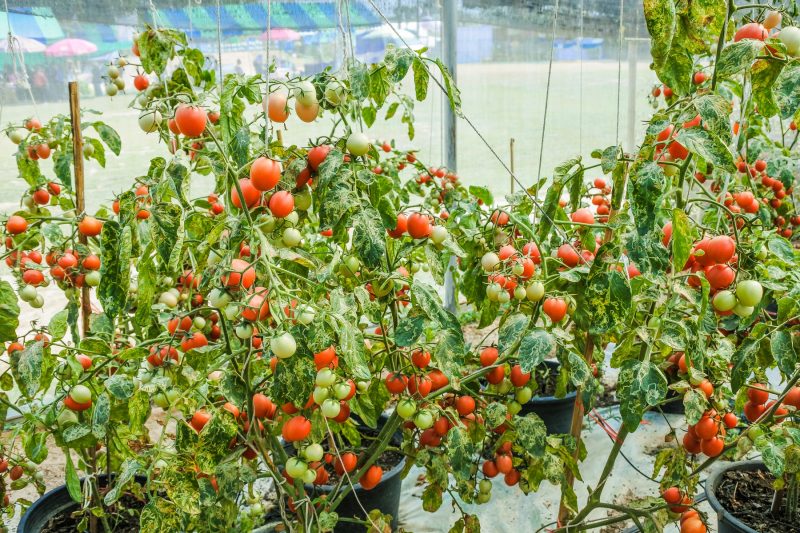Gardeners must know how much lighting is used growing tomatoes in a commercial greenhouse, which is 60 Watts/m2 for 16 to 18 hours per day. Regardless if you’re growing in the greenhouse for business or personal use, it’s crucial to generate the optimal conditions indoors for your plants to thrive. A common mistake is to focus on the ideal temperature for growing tomatoes only and then neglect the lighting.
Much like temperature, the lighting system in the greenhouse plays a significant role in the success of your tomato garden. Plants won’t be able to perform photosynthesis if the conditions indoors are incomplete. Tomatoes thrive in full sun, but because we don’t want to overheat the greenhouse, supplemental lighting is the best solution to provide their lighting requirements.

What You Need To Know On How Much Lighting Is Used Growing Tomatoes In Commercial Greenhouse
In general, the amount of lighting that tomatoes require in a commercial greenhouse is 60 Watts/m2 for 16 to 18 hours per day. This is recommended both for sowing and transplanting by the government of Alberta. Since you’ll be running a commercial tomato greenhouse, it’s crucial to plan the lighting system and how to achieve this requirement.
Sowing
In the seedling nursery, high-pressure sodium lights will provide this condition. However, the placement of the lights is also prominent. Have the lights 6 feet above the seedlings and a distance of 9 feet between each light. Each row of light will then have 12 feet of space between them.
Transplanting
Once you see the first real leaves appear, you will have to transplant the seedlings. The amount of lighting is still the same, but Alberta also recommends adding carbon dioxide supplementation. According to their findings, this combination will improve early yields.
You will eventually have to reduce the lighting duration to 12 hours a week before you begin the second transplanting. This way, you can condition the transplants to the main greenhouse changes and avoid light shock. Otherwise, their development will halt.
How Lighting Affects Tomatoes In Commercial Greenhouse
Now that you know the amount of lighting for the growth of tomatoes, you must learn what makes lighting crucial in a commercial greenhouse. For starters, the color of growing lights affects plants’ growth because they will dictate the similarity with the spectrum your plants use. Additionally, we all know that maximum light intensity will create the best fruit set.
This is the same reason why you’ll notice a higher yield in the spring compared to fall. Additionally, failure to provide the optimal lighting conditions will even prevent the tomato plants from developing flowers. Instead, they will only produce leaves and stems until there is light to support the flower and fruit.
You must also be consistent in providing the optimal conditions throughout the growing season. For example, if the plants experience a sudden limitation, they risk getting smaller fruits. This will reduce the yield and even the quality of your harvest.
What Is The Best Light For Growing Tomatoes In Commercial Greenhouse?
For growing tomatoes in a commercial greenhouse, you must know which type of light would be the best choice. High-pressure sodium lights are an economical choice in a commercial greenhouse. Cornell University also mentioned that they are great for increasing light intensity and extending day length.
However, you must always check the setup of high-pressure sodium lights so that you’ll get uniform lighting in the entire greenhouse. But what about LED lights? Are LED lights the right choice for commercial greenhouse tomato production?
LED lights help in increasing the fruit number and yield. More so, using them in comparison to other supplemental lighting shows an increase in energy savings. Over time, you will have lesser expenses and higher profits.
Is Growing Tomatoes A Good Business?
Growing tomatoes is a good business because of the rapid growth of the industry. Using a greenhouse for production is a good strategy. This is because you will always be able to provide tomatoes at an excellent price, especially when they are out of season.
You won’t need to worry about unpredictable weather and diseases. Using a greenhouse will ensure a steady production volume, and while you’ll also need to allocate budget being indoors, you can always learn about economic strategies. As mentioned by the Mississippi State University Extension Service, the success of a commercial greenhouse tomato production will depend on your management skills.
Proactiveness and consistent attention are vital characteristics that you must possess.
Conclusion
As previously discussed, growing tomatoes in a commercial greenhouse is an excellent investment to venture into. However, you must know the proper management practices, including how much lighting is used growing tomatoes in a commercial greenhouse. For sowing and transplanting, the recommendation is 60 Watts/m2 for 16 to 18 hours per day.
Ensuring the proper lighting in the greenhouse has a considerable impact on the production and yield of your crops. For the type of lighting system to use, extensions both discussed the advantages and disadvantages of LED lights and high-pressure sodium lights. Choosing between the two will depend on which you think is more beneficial for your situation.
Overall, the lighting system is a part of a greenhouse that gardeners must never neglect. Regardless of the crop you have, you must meet their requirements to ensure a productive greenhouse.
